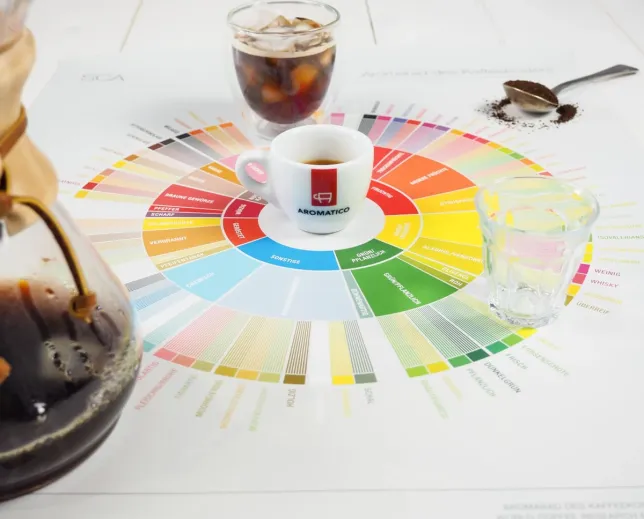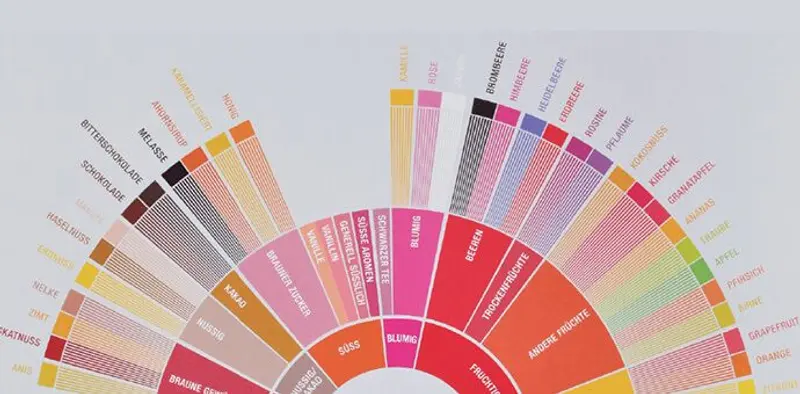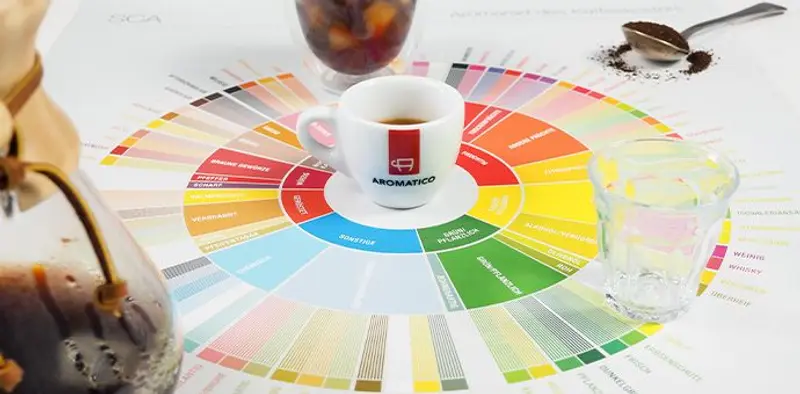Flavor wheel

When buying coffee, people often decide according to taste, but which flavors can be distinguished in coffee? Learn all about the topic of aromas in coffee and the aroma wheel now!
Suitable coffees
The coffee taster's favourite wheel: the colorful aroma diversity of coffee.
A coffee bean contains around 800 aromas, which unfold their flavor diversity during extraction by hot water. This makes the aroma spectrum of the green bean twice as extensive as that of wine. You can get an overview of the flavor of a coffee variety by looking at its flavor profile. If you want to know how this comes about and delve deeper into the fascinating world of coffee aromas, the aroma wheel is the perfect tool for getting to know the different flavor notes better.

THE FLAVOR WHEEL FOR COFFEE: THE COLORS OF FLAVOR
The flavor wheel - originally called "The Coffee Taster's Flavor Wheel" - was developed by the Specialty Coffee Association (SCA) in 1995. Since then, the wheel has set the standard in the coffee industry for describing and categorizing flavors: clear and circular, with a wide range of colors whose nuances correspond to individual flavors. In 2016, after three years of collaboration with World Coffee Research (WCR), the SCA released a new, contemporary version of The Coffee Taster's Flavor Wheel, which now serves as a standard for the entire industry. The foundation of this work is the World Coffee Research Sensory Lexicon: the most comprehensive research on coffee flavor published to date. This work on sensory science was created with the help of numerous scientists, coffee tasters, and roasters who collaborated with the SCA and WCR at an unprecedented level of intensity.
An excursus on the perception of aromas
Aromas refer to sensory impressions such as scents and tastes in equal measure. Their olfactory and gustatory perception often takes place simultaneously, and sometimes just one smell is enough to literally taste it.
- Odors are processed by olfactory receptors, which transmit them to the limbic center of the brain; this is where memories and their associations with odors are stored.
- The perception of taste takes place via the taste buds on the tongue; here we distinguish between sour, bitter, sweet, salty and umami.
- Appropriately trained noses can distinguish a thousand scents or more from each other, while the sense of taste only allows the differentiation of five variations.
How to use "the coffee taster's flavor wheel"
The flavor wheel for coffee allows a detailed classification of individual varieties, closely related to that of wine. In both cases, meaningful flavor profiles are created, which are used by experts and laymen alike. The aroma wheel is available - in different languages - in the form of a poster. This allows you to see the variations of coffee aromas at a glance in an appealing, colorful presentation.
The eleven basic shades are divided into the following categories, each of which in turn is subdivided into different areas:
- Floral
- Herbal
- Vegetal
- Spices
- Woods
- Nuts
- Roasted flavors
- Mineral
- Chemical
- Microbiological
- Fruity

The latter is divided, for example, into the four subcategories "berries," "dried," "other," and "citrus fruits," each of which is also subdivided into subordinate categories. The type and duration of roasting, as well as the degree of roasting achieved, summarized as "roasting method," the temperature of the water and the preparation method also result in a wide variety of flavor nuances. Using the aroma wheel for coffee opens up an undreamt-of variety of aromas that you can now consciously discover in your coffee by tasting it. This also makes it easier for you to learn more about the character of your favorite coffees.

Conclusion
With 800 different aromas, the aroma diversity of coffee is unique compared to other food and beverages. From cultivation to roasting to proper storage at your home, all processes can influence the aromas and especially the intensity of the aromas. With the aroma wheel, the many aromas can be classified and distinguished. Thus, the classification is made from the basic flavors to the respective subcategories of the flavors.



















